On which of the following organizational resources is the lack of an enabled password or PIN a common vulnerability?
A security administrator recently deployed a virtual honeynet. The honeynet is not protected by the company’s firewall, while all production networks are protected by a stateful firewall. Which of the following would BEST allow an external penetration tester to determine which one is the honeynet’s network?
A company requests a security assessment of its network. Permission is given, but no details are provided. It is discovered that the company has a web presence, and the company’s IP address is 70.182.11.4. Which of the following Nmap commands would reveal common open ports and their versions?
A company has a popular shopping cart website hosted geographically diverse locations. The company has started hosting static content on a content delivery network (CDN) to improve performance. The CDN provider has reported the company is occasionally sending attack traffic to other CDN-hosted targets.
Which of the following has MOST likely occurred?
While reviewing three months of logs, a security analyst notices probes from random company laptops going to SCADA equipment at the company’s manufacturing location. Some of the probes are getting responses from the equipment even though firewall rules are in place, which should block this type of unauthorized activity. Which of the following should the analyst recommend to keep this activity from originating from company laptops?
A datacenter manager just received an SMS alert that a server cage was accessed using an authorized code. The manager does not recall receiving a notification by email for any scheduled maintenance on servers In the cage. Which of the following Is the FIRST step the manager should take?
A cyber incident response team finds a vulnerability on a company website that allowed an attacker to inject malicious code into its web application. There have been numerous unsuspecting users visiting the infected page, and the malicious code executed on the victim’s browser has led to stolen cookies, hijacked sessions, malware execution, and bypassed access control. Which of the following exploits is the attacker conducting on the company’s website?
Which of the following describes why it is important to include scope within the rules of engagement of a penetration test?
A cybersecurity consultant found common vulnerabilities across the following services used by multiple servers at an organization: VPN, SSH, and HTTPS. Which of the following is the MOST likely reason for the discovered vulnerabilities?
An analyst was investigating the attack that took place on the network. A user was able to access the system without proper authentication. Which of the following will the analyst recommend, related to management approaches, in order to control access? (Choose three.)
A security analyst performed a review of an organization’s software development life cycle. The analyst reports that the life cycle does not contain in a phase in which team members evaluate and provide critical feedback on another developer’s code. Which of the following assessment techniques is BEST for describing the analyst’s report?
After reviewing security logs, it is noticed that sensitive data is being transferred over an insecure network. Which of the following would a cybersecurity analyst BEST recommend that the organization implement?
A security administrator has uncovered a covert channel used to exfiltrate confidential data from an internal database server through a compromised corporate web server. Ongoing exfiltration is accomplished by embedding a small amount of data extracted from the database into the metadata of images served by the web server. File timestamps suggest that the server was initially compromised six months ago using a common server misconfiguration. Which of the following BEST describes the type of threat being used?
A cybersecurity analyst is investigating an incident report concerning a specific user workstation. The workstation is exhibiting high CPU and memory usage, even when first started, and network bandwidth usage is extremely high. The user reports that applications crash frequently, despite the fact that no significant changes in work habits have occurred. An antivirus scan reports no known threats. Which of the following is the MOST likely reason for this?
A cybersecurity analyst is conducting packet analysis on the following:

Which of the following Is occurring in the given packet?
During a recent breach, an attacker was able to use tcpdump on a compromised Linux server to capture the password of a network administrator that logged into a switch using telnet.
Which of the following compensating controls could be implemented to address this going forward?
While conducting research on malicious domains, a threat intelligence analyst received a blue screen of death. The analyst rebooted and received a message stating that the computer had been locked and could only be opened by following the instructions on the screen. Which of the following combinations describes the MOST likely threat and the PRIMARY mitigation for the threat?
A security analyst is concerned that a default administrator account on workstations will make it easy for a threat actor to move laterally throughout the domain. The security analyst has the approval to remediate the risk. Which of the following solutions would achieve this objective? (Select TWO.)
A cybersecurity analyst was asked to review several results of web vulnerability scan logs.
Given the following snippet of code:

Which of the following BEST describes the situation and recommendations to be made?
An employee was conducting research on the Internet when a message from cyber criminals appeared on the screen, stating the hard drive was just encrypted by a ransomware variant. An analyst observes the following:
Which of the following describes how the employee got this type of ransomware?
A security analyst Is trying to capture network traffic In a web server that is suspected of using the DNS service for exfiltrating Information out of the network. The server usually transfers several gigabytes of data per day. and the analyst wants the size of the capture to be as reduced as possible. Which of the following commands should the analyst use to achieve such goals?
The security operations team underwent an audit and found that meeting full compliance Is causing severe Impact to critical systems. Which of the following should the security analyst recommend?
A security analyst was asked to join an outage call for a critical web application. The web middleware support team determined the web server is running and having no trouble processing requests; however, some investigation has revealed firewall denies to the web server that began around 1.00 a.m. that morning. An emergency change was made to enable the access, but management has asked for a root cause determination. Which of the following would be the BEST next step?
Which of the following has the GREATEST impact to the data retention policies of an organization?
During a routine network scan, a security administrator discovered an unidentified service running on a new embedded and unmanaged HVAC controller, which is used to monitor the company’s datacenter:

The enterprise monitoring service requires SNMP and SNMPTRAP connectivity to operate. Which of the following should the security administrator implement to harden the system?
A SIEM analyst noticed a spike in activities from the guest wireless network to several electronic health record (EHR) systems. After further analysis, the analyst discovered that a large volume of data has been uploaded to a cloud provider in the last six months. Which of the following actions should the analyst do FIRST?
A nuclear facility manager determined the need to monitor utilization of water within the facility. A startup company just announced a state-of-the-art solution to address the need for integrating the business and ICS network. The solution requires a very small agent to be installed on the ICS equipment. Which of the following is the MOST important security control for the manager to invest in to protect the facility?
A systems administrator is trying to secure a critical system. The administrator has placed the system behind a firewall, enabled strong authentication, and required all administrators of this system to attend mandatory training.
Which of the following BEST describes the control being implemented?
A pharmacy gives its clients online access to their records and the ability to review bills and make payments. A new SSL vulnerability on a special platform was discovered, allowing an attacker to capture the data between the end user and the web server providing these services. After investigating the platform vulnerability, it was determined that the web services provided are being impacted by this new threat.
Which of the following data types are MOST likely at risk of exposure based on this new threat? (Choose two.)
A security analyst has noticed an alert from the SIEM. A workstation is repeatedly trying to connect to port 445 of a file server on the production network. All of the attempts are made with invalid credentials. Which of the following describes what is occurring?
A malware infection spread to numerous workstations within the marketing department. The workstations were quarantined and replaced with machines.
Which of the following represents a FINAL step in the eradication of the malware?
A cybersecurity professional wants to determine if a web server is running on a remote host with the IP address 192.168.1.100. Which of the following can be used to perform this task?
The business has been informed of a suspected breach of customer data. The internal audit team, in conjunction with the legal department, has begun working with the cybersecurity team to validate the report. To which of the following response processes should the business adhere during the investigation?
Nmap scan results on a set of IP addresses returned one or more lines beginning with “cpe:/o:” followed by a company name, product name, and version. Which of the following would this string help an administrator to identify?
A Chief Information Security Officer (CISO) wants to standardize the company’s security program so it can be objectively assessed as part of an upcoming audit requested by management.
Which of the following would holistically assist in this effort?
Which of the following tools should a cybersecurity analyst use to verify the integrity of a forensic image before and after an investigation?
A business-critical application is unable to support the requirements in the current password policy because it does not allow the use of special characters. Management does not want to accept the risk of a possible security incident due to weak password standards. Which of the following is an appropriate means to limit the risks related to the application?
The Chief Executive Officer (CEO) instructed the new Chief Information Security Officer (CISO) to provide a list of enhancement to the company’s cybersecurity operation. As a result, the CISO has identified the need to align security operations with industry best practices. Which of the following industry references is appropriate to accomplish this?
A security analyst is reviewing logs and discovers that a company-owned computer issued to an employee is generating many alerts and warnings. The analyst continues to review the log events and discovers that a non-company-owned device from a different, unknown IP address is generating the same events. The analyst informs the manager of these findings, and the manager explains that these activities are already known and part of an ongoing events. Given this scenario, which of the following roles are the analyst, the employee, and the manager filling?
Following a recent security breach, a post-mortem was done to analyze the driving factors behind the breach. The cybersecurity analysis discussed potential impacts, mitigations, and remediations based on current events and emerging threat vectors tailored to specific stakeholders. Which of the following is this considered to be?
An organization uses Common Vulnerability Scoring System (CVSS) scores to prioritize remediation of vulnerabilities.
Management wants to modify the priorities based on a difficulty factor so that vulnerabilities with lower CVSS scores may get a higher priority if they are easier to implement with less risk to system functionality. Management also wants to quantify the priority. Which of the following would achieve management’s objective?
A company has several internal-only, web-based applications on the internal network. Remote employees are allowed to connect to the internal corporate network with a company-supplied VPN client. During a project to upgrade the internal application, contractors were hired to work on a database server and were given copies of the VPN client so they could work remotely. A week later, a security analyst discovered an internal web-server had been compromised by malware that originated from one of the contractor’s laptops. Which of the following changes should be made to BEST counter the threat presented in this scenario?
A threat intelligence analyst who works for a financial services firm received this report:
“There has been an effective waterhole campaign residing at This domain is delivering ransomware. This ransomware variant has been called “LockMaster” by researchers due to its ability to overwrite the MBR, but this term is not a malware signature. Please execute a defensive operation regarding this attack vector.”
The analyst ran a query and has assessed that this traffic has been seen on the network. Which of the following actions should the analyst do NEXT? (Select TWO).
A security analyst is concerned that employees may attempt to exfiltrate data prior to tendering their resignations. Unfortunately, the company cannot afford to purchase a data loss prevention (DLP) system. Which of the following recommendations should the security analyst make to provide defense-in-depth against data loss? (Select THREE).
Which of the following stakeholders would need to be aware of an e-discovery notice received by the security office about an ongoing case within the manufacturing department?
After a recent security breach, it was discovered that a developer had promoted code that had been written to the production environment as a hotfix to resolve a user navigation issue that was causing issues for several customers. The code had inadvertently granted administrative privileges to all users, allowing inappropriate access to sensitive data and reports. Which of the following could have prevented this code from being released into the production environment?
A cybersecurity analyst is completing an organization’s vulnerability report and wants it to reflect assets accurately. Which of the following items should be in the report?
A company has recently launched a new billing invoice website for a few key vendors. The cybersecurity analyst is receiving calls that the website is performing slowly and the pages sometimes time out. The analyst notices the website is receiving millions of requests, causing the service to become unavailable. Which of the following can be implemented to maintain the availability of the website?
An organization has recently recovered from an incident where a managed switch had been accessed and reconfigured without authorization by an insider. The incident response team is working on developing a lessons learned report with recommendations. Which of the following recommendations will BEST prevent the same attack from occurring in the future?
The developers recently deployed new code to three web servers. A daily automated external device scan report shows server vulnerabilities that are failing items according to PCI DSS.
If the vulnerability is not valid, the analyst must take the proper steps to get the scan clean.
If the vulnerability is valid, the analyst must remediate the finding.
After reviewing the information provided in the network diagram, select the STEP 2 tab to complete the simulation by selecting the correct Validation Result and Remediation Action for each server listed using the drop-down options.
Instructions
STEP 1: Review the information provided in the network diagram.
STEP 2: Given the scenario, determine which remediation action is required to address the vulnerability.
If at any time you would like to bring back the initial state of the simulation, please select the Reset All button.
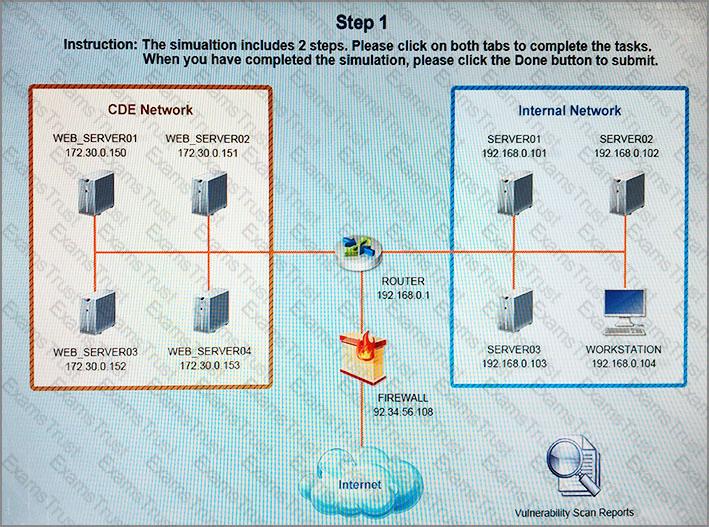
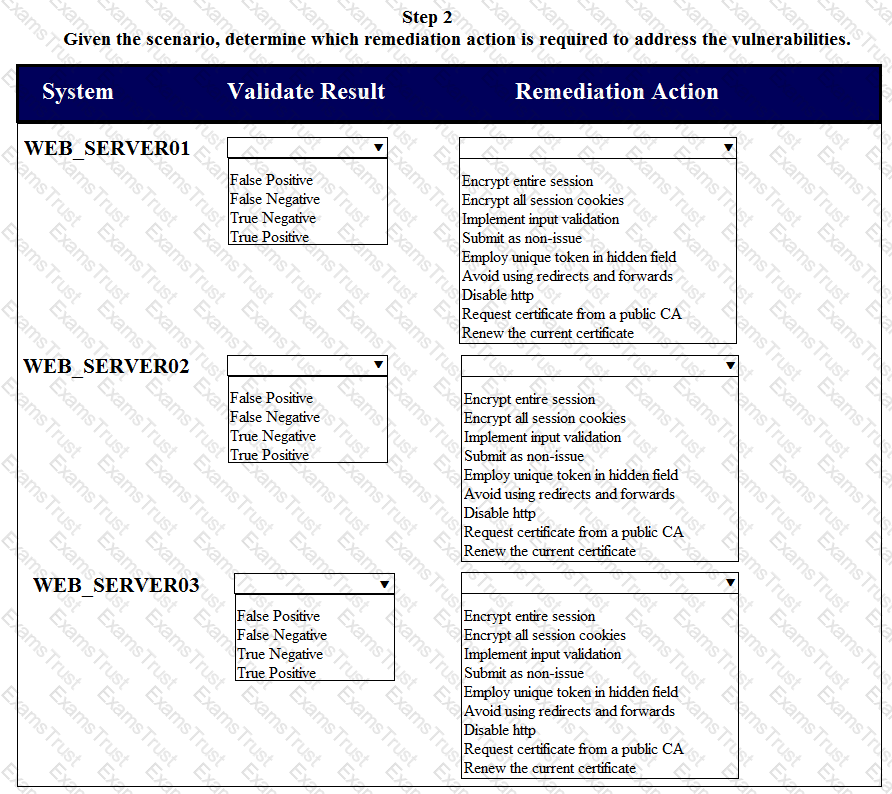
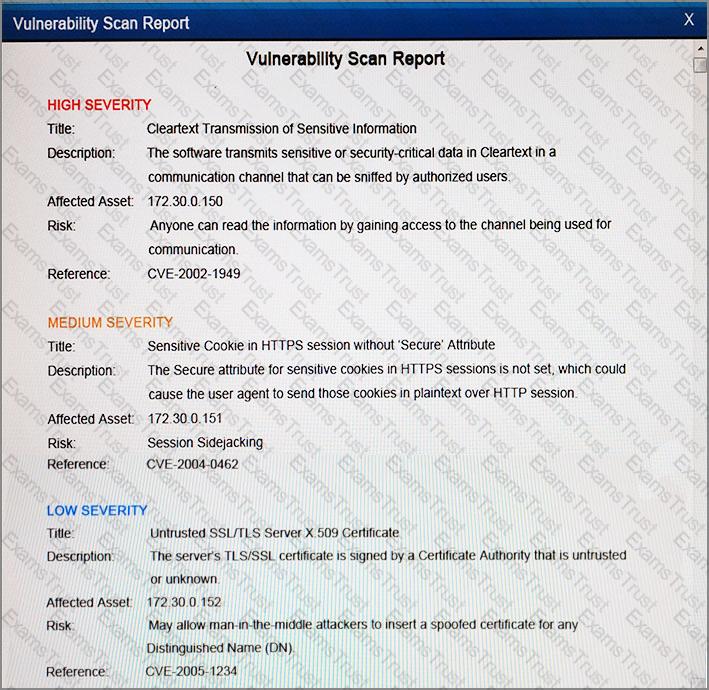
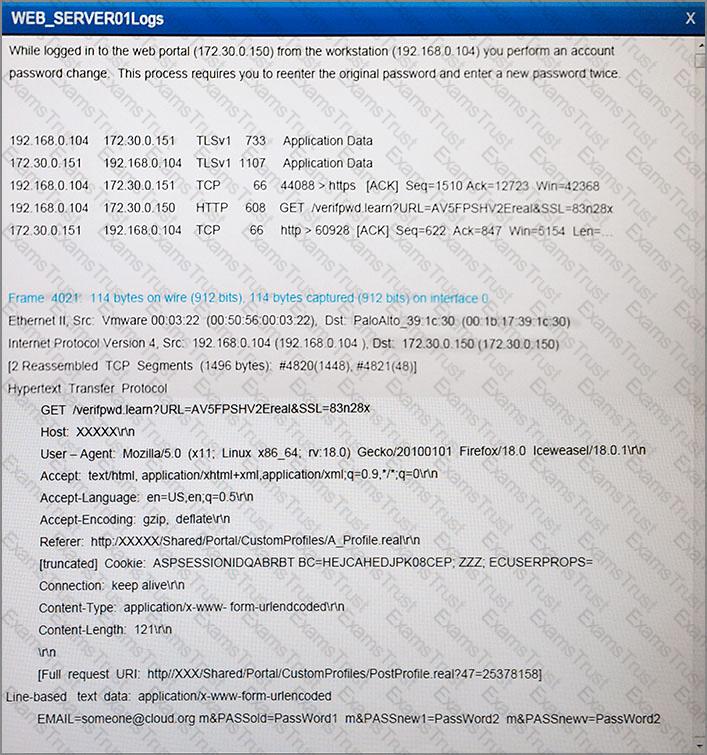
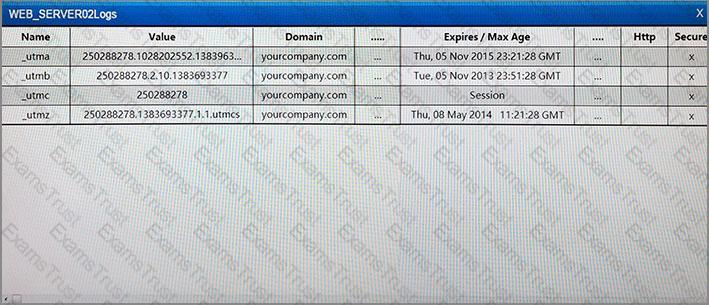
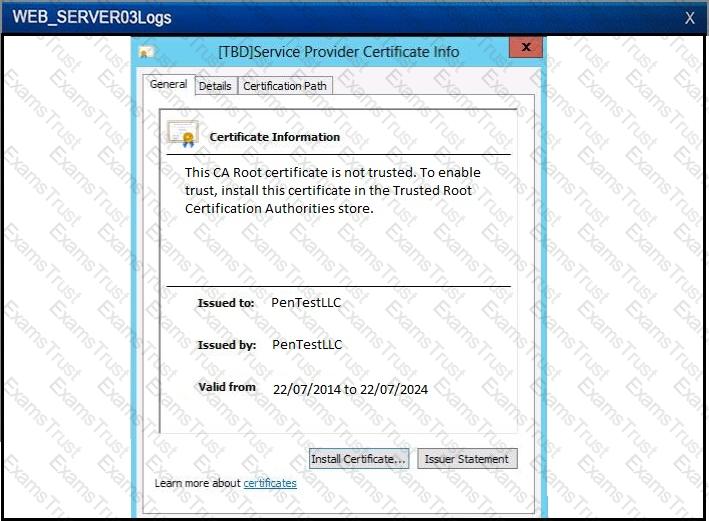
A company wants to update its acceptable use policy (AUP) to ensure it relates to the newly implemented password standard, which requires sponsored authentication of guest wireless devices. Which of the following is MOST likely to be incorporated in the AUP?
A company that is hiring a penetration tester wants to exclude social engineering from the list of authorized activities. Which of the following documents should include these details?
An analyst finds that unpatched servers have undetected vulnerabilities because the vulnerability scanner does not have the latest set of signatures. Management directed the security team to have personnel update the scanners with the latest signatures at least 24 hours before conducting any scans, but the outcome is unchanged. Which of the following is the BEST logical control to address the failure?
After analyzing and correlating activity from multiple sensors, the security analyst has determined a group from a high-risk country is responsible for a sophisticated breach of the company network and continuous administration of targeted attacks for the past three months. Until now, the attacks went unnoticed. This is an example of:
A security analyst is adding input to the incident response communication plan. A company officer has suggested that if a data breach occurs, only affected parties should be notified to keep an incident from becoming a media headline. Which of the following should the analyst recommend to the company officer?
A security analyst received a compromised workstation. The workstation’s hard drive may contain evidence of criminal activities. Which of the following is the FIRST thing the analyst must do to ensure the integrity of the hard drive while performing the analysis?
Which of the following best practices is used to identify areas in the network that may be vulnerable to penetration testing from known external sources?
Which of the following principles describes how a security analyst should communicate during an incident?
During a routine review of firewall logs, an analyst identified that an IP address from the organization’s server subnet had been connecting during nighttime hours to a foreign IP address, and had been sending between 150 and 500 megabytes of data each time. This had been going on for approximately one week, and the affected server was taken offline for forensic review. Which of the following is MOST likely to drive up the incident’s impact assessment?
A cybersecurity analyst has received an alert that well-known “call home” messages are continuously observed by network sensors at the network boundary. The proxy firewall successfully drops the messages. After determining the alert was a true positive, which of the following represents the MOST likely cause?
Which of the following represent the reasoning behind careful selection of the timelines and time-of-day boundaries for an authorized penetration test? (Select TWO).
Using a heuristic system to detect an anomaly in a computer’s baseline, a system administrator was able to detect an attack even though the company signature based IDS and antivirus did not detect it. Further analysis revealed that the attacker had downloaded an executable file onto the company PC from the USB port, and executed it to trigger a privilege escalation flaw. Which of the following attacks has MOST likely occurred?
A vulnerability scan has returned the following information:
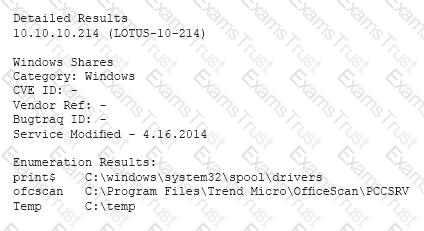
Which of the following describes the meaning of these results?
When network administrators observe an increased amount of web traffic without an increased number of financial transactions, the company is MOST likely experiencing which of the following attacks?
An analyst is observing unusual network traffic from a workstation. The workstation is communicating with a known malicious site over an encrypted tunnel. A full antivirus scan with an updated antivirus signature file does not show any sign of infection. Which of the following has occurred on the workstation?
A cybersecurity analyst is currently investigating a server outage. The analyst has discovered the following value was entered for the username: 0xbfff601a. Which of the following attacks may be occurring?
An analyst was tasked with providing recommendations of technologies that are PKI X.509 compliant for a variety of secure functions. Which of the following technologies meet the compatibility requirement? (Select three.)
A software assurance lab is performing a dynamic assessment on an application by automatically generating and inputting different, random data sets to attempt to cause an error/failure condition. Which of the following software assessment capabilities is the lab performing AND during which phase of the SDLC should this occur? (Select two.)